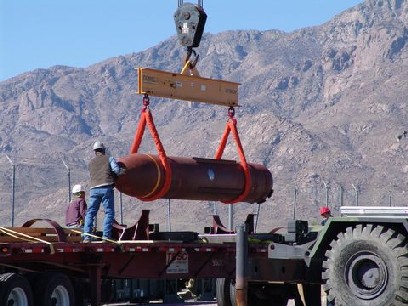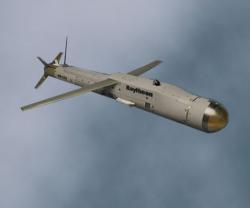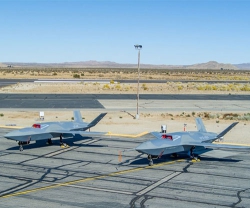A 'bunker buster' bomb with more than 10 times the explosive power of its predecessor is to be put into service by the United States next December, six months later than previously scheduled, the Defence Department said.
The deployment's timing may help shape new calculations in long standoffs with Iran and North Korea over their nuclear programs, much of which are believed to be underground to avoid detection and enhance their chances of surviving an attack.
The precision-guided, 30,000-pound (13,636 kilos) Massive Ordnance Penetrator, or MOP, is designed to destroy potential targets such as deeply buried facilities that are beyond the reach of existing penetrating bombs.
'Funding delays and enhancements to the planned test schedule have pushed the capability availability date to December 2010,' Tara Rigler, a Pentagon Spokeswoman, said in an email on Friday.
Congress agreed to a Pentagon request, made public in August, to shift fiscal 2009 budget funds to speed the Boeing Company -built bomb's tie-in to the radar-evading B-2 bomber, the most advanced in the US arsenal.
At the time, Andy Bourland, an Air Force Spokesman, had said B-2, built by Northrop Grumman Corp., would be capable of carrying the bomb by July 2010.
In disclosing the new deployment target, the Defence Department specified it did not plan to use older B-52 Stratofortress bombers as an 'operational delivery platform' for the MOP, which will be the largest US non-nuclear bomb.
It is designed to penetrate up to 200 feet (61 metres) underground before exploding, according to an article published by the Air Force.
MOP testing is being carried out by the Air Force and the Defense Threat Reduction Agency, which is responsible for safeguarding the United States and its allies from weapons of mass destruction.
The bomb's fourth flight test was successfully completed on Tuesday at White Sands Missile Range in White Sands, New Mexico, using a B-52 and an 'inert' MOP, Rigler said.
The MOP's planned deployment 'amounts to a message to Iran,' said Kenneth Katzman, an Iran expert for the US Congress. 'It cannot count on the main elements of its nuclear program surviving if there is a conflict.'
Military analysts doubt Israel could disable Iran's nuclear facilities in a raid even with dozens of aircraft. Tehran has had years to build covert facilities, spread elements of its programs and develop options for recovering from an attack.
'Strong as Israeli forces are, they lack the scale, range and other capabilities to carry out the kind of massive strike the US could launch,' Anthony Cordesman, a former Pentagon Strategist now at the Center for Strategic and International Studies, wrote in September.
The MOP packs some 2,404 kilos of explosives, more than 10 times the amount of its predecessor bunker buster, the 907-kilo BLU-109, according to the threat reduction agency, which funded its development.
In a July 8 funding acceleration request to Congress, the Defence Department said the MOP was the 'weapon of choice' to meet an urgent operational need.
The MOP would be about one-third heavier than the 9,500 kg GBU-43/B Massive Ordnance Air Blast bomb, previously dubbed the 'Mother of all Bombs'.






















